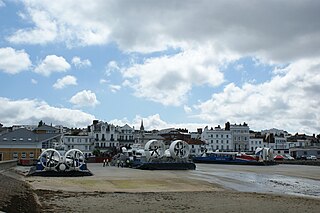
The PS Medway Queen is a paddle driven steamship, the only mobile estuary paddle steamer left in the United Kingdom. She was one of the "little ships of Dunkirk", making a record seven trips and rescuing 7000 men in the evacuation of Dunkirk.
Three ships of the Royal Navy have been named HMS Sandown. Sandown is a seaside resort on the Isle of Wight, England.

William Denny and Brothers Limited, often referred to simply as Denny, was a Scottish shipbuilding company.

PS Ryde is a paddle steamer that was commissioned and run by Southern Railway as a passenger ferry between mainland England and the Isle of Wight from 1937 to 1969, with an interlude during the Second World War where she served as a minesweeper and then an anti-aircraft ship, seeing action at both Dunkirk and D-Day. After many years abandoned on moorings at Island Harbour Marina on the River Medina, she was purchased by the PS Ryde Trust in late 2018, with the intention of raising money for her restoration. That project was abandoned in January 2019.

TSMV Shanklin was a passenger ferry that operated between Portsmouth and the Isle of Wight between 1951 and 1980. Renamed Prince Ivanhoe she went on to become a pleasure cruiser in the Bristol Channel but in 1981 sank off the Welsh coast on her first season.

There are currently three different ferry companies that operate vessels carrying passengers and, on certain routes, vehicles across the Solent, the stretch of sea that separates the Isle of Wight from mainland England. These are Wightlink, Red Funnel and Hovertravel.
Duchess of Norfolk was a 381 GRT paddle steamer built in 1911 for the London, Brighton and South Coast Railway and London and South Western Railway, who operated a joint service to the Isle of Wight. She was requisitioned by the Royal Navy for use as minesweeper HMS Duchess of Norfolk during the First World War, returning to her owners after the war ended. She passed to the Southern Railway on 1 January 1923.

PS Jeanie Deans was a Clyde paddle steamer, built in 1931 for the London and North Eastern Railway. She was a popular boat, providing summer cruises from Craigendoran until 1964.

This article describes the shipping services of the London and South Western Railway and the vessels employed.
PS Killingholme was a passenger and cargo vessel built for the Great Central Railway in 1912.
SS Laura was a passenger vessel built for the London and South Western Railway in 1885.

PS Shanklin was a passenger vessel built for the Southern Railway in 1924 for use on the Portsmouth Harbour to Ryde Pier route.
PS Portsdown was a passenger vessel built for the Southern Railway in 1928. She was one of the civilian ships that participated in the Dunkirk evacuation in 1940 and was sunk by a naval mine a year later.
PS Southsea was a passenger vessel built for the Southern Railway in 1930. Requisitioned by the Royal Navy for war service, she was wrecked after hitting a naval mine in 1941.

PS Whippingham was a passenger paddle steamer built for the Southern Railway in 1930 for the ferry route to the Isle of Wight. After distinguished war service, she returned to ferry work until she was scrapped in 1963.
HMS Snaefell was a paddle steamer, built at John Brown & Company's Clydebank shipyard for the Barry Railway Company and launched on 1907 as the PS Barry. Built to serve as a pleasure steamer carrying passengers on the Bristol Channel, she was quickly transferred to the ownership of Bristol Channel Passenger Boats which in 1911 became part of P & A Campbell.
PS Waverley was a Clyde-built paddle steamer that carried passengers on the Clyde between 1899 and 1939. She was requisitioned by the Admiralty to serve as a minesweeper during World War I and again in World War II, and was sunk while participating in the Dunkirk evacuation in 1940. The current PS Waverley, launched in 1946, was built as a replacement for this vessel.

PS Duchess of Fife was a paddle steamer built in 1903 for the Caledonian Steam Packet Company. She spent most of her career serving passenger routes in the Firth of Clyde and was requisitioned for use as a minesweeper during both World Wars. In 1940 she took part in the Dunkirk evacuation, rescuing a total of 1,633 allied troops.

TSMV Brading was a passenger ferry that operated between Portsmouth and the Isle of Wight between 1948 and 1986.

TSMV Southsea was a passenger ferry that operated between Portsmouth and the Isle of Wight between 1948 and 1987.













